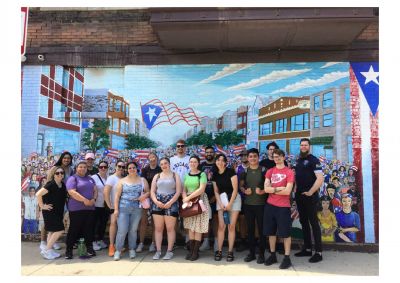Today our group explored a Puerto Rican community on the North side of Chicago, in Humboldt Park. Here we heard first-hand account and personal testimonies regarding how this community came to be and how they hold on to their traditions and sense of anticolonialist rebellion.
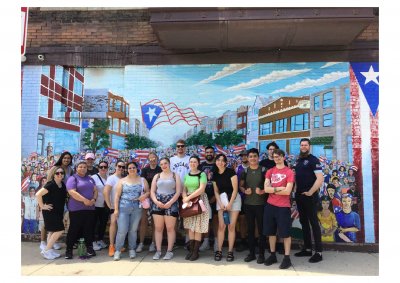
Our guide, Eduardo, is a native of the area. He began the tour with an introduction of an art piece at the start of the neighborhood. It was a 60 ton steel Puerto Rican flag that greets all visitors entering the community. Eduardo expressed how difficult it was to establish the community due to the constant relocating of the Puerto Rican community in Chicago. He spoke of how they originally had neighborhoods established all over Chicago, but gentrification ran its course and the people were unofficially kicked out of their areas. The flag represents their home and where it starts and ends. A sign of hope for the future. In Eduardo’s words “Everytime they moved us we grew poorer while they grew richer.”
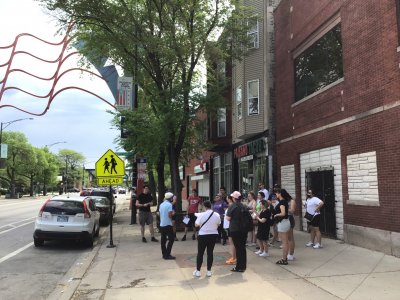
From there, we learned quickly a few numbers that stood out: approximately 1/3rd of the Puerto Rican population migrated to the mainland US in the 20th century, and many were given citizenship immediately before World War One kicked off in 1917 so that they could be drafted. Eduardo’s own grandfather was drafted at the age of 17. Eduardo went on to explain the walk-of-fame and about the five inductees into the neighborhood’s honorary group. He also reinforced the notion that while these few stretches of land were primarily Puerto Rican, the population is quite small compared to other cultural hubs like New York City and Philadelphia. Chicago now has nearly 100,000 Puerto Ricans, while other major cities house more than a million. The gentrification of the area forced constant movement, so the neighborhood was established as a stronghold of sorts and is literally bordered by massive Puerto Rican steel structures.
The next stop was Nellies Puerto Rican restaurant, an outwardly small cafe-style place that expanded beyond its front doors. Upon entering the restaurant, the others were greeted with great smells and I (Dante) heard others in our group immediately comment on how good the food at other tables looked and how wonderful everything smelled. Everyone inside was very polite, and as we made our menu selections, Eduardo was kind enough to offer recommendations for the table. Many of us followed through on his advice, getting the Jibarito bowls or sandwiches, which combined a delicious medley of plantains, bistec, chicken, or vegetarian options. Several of us also sampled the establishment’s signature dish; the coconut oatmeal, which they proudly touted on the window outside as the best in Chicago. It delivered. The oatmeal provided a rich coconut flavor without being overpowering, and was topped with several dashes of cinnamon in the shape of a smiley face! Each of us on this blog ordered different meals, as we all wanted to get a different taste of cuisine. I ordered a Cubano, which again delivered on flavor, and the habanero sauce provided at the table elevated the dish to another level.
Boriken is actually the original name of Puerto Rico. Given by the native settlers, the Taíno, before the other Spanish colonies took over. Other countries like Jamaica and Hadi actually still have the original name given to them by the Taíno’s.
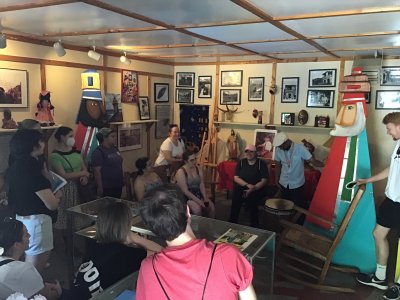
We were then allowed to enter La Casita de Don Pedro. It was named after a Puerto Rican activist , Dr. Pedro Albizu Campos. The monument is about Puerto Rican activists who fought for Puerto Rican rights in America and in Puerto Rico. The last Puerto Rican in jail for crimes due to activism was not realized until Obama pardoned her in 2016. This monument is made to show how Puerto Ricans got the rights they have today and as a symbol to keep fighting for your rights. There are many boomba and boomba dancers performing here. Boomba is a short fat drum made by Purrto Ricans. The drummer makes or coordinates the beat and the dancers try to anticipate it and dance to the drummer.
Following the introduction to the neighborhood, we were introduced as a group to the 70+ murals that were dotted throughout the neighborhood. Several murals have existed since the early 1970s, while others were completed as early as last year, with each and every piece of art representing a significant part of the neighborhoods cultural significance.
One of the most important things we noticed about this neighborhood that we didn’t in the other ones was the amount of art in the streets. On every block, every corner, every street light there was art by a member of the community. It was beautiful how these murals represented the struggle and celebration of this community. The mural that stuck out the most to the group was made after the murder of a member of the community by the hands of law enforcement. It shows the passion this community has and highlights the “rebellion in their blood”. Our guide told us that many of these art pieces have political meaning because it was sort of their heritage to fight, to go against our oppressors. This was reflected all over the town and shows the bond this community has.
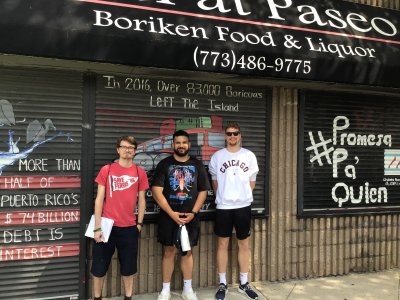
Dante Stanton, Erick Martinez, Ian Fox (left to right)





